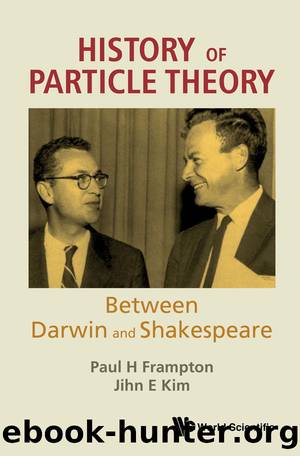History Of Particle Theory: Between Darwin And Shakespeare by Paul H Frampton;Jihn E Kim;

Author:Paul H Frampton;Jihn E Kim;
Language: eng
Format: epub
ISBN: 9789811224676
Publisher: World Scientific Publishing Company
Published: 2021-12-15T00:00:00+00:00
Chapter 6
Particle Theory
In 1942, the wartime Manhattan Project gathered the US talents in nuclear physics at Los Alamos, New Mexico. The project, led by Major General Leslie Groves (1896â1970) and theoretical physicist Robert Oppenheimer (1904â1967), succeeded in making the atomic bomb which was tested in the New Mexico Desert at 5:30 a.m. on July 16, 1945 with an energy equivalent of around 20 kilotons of TNT, having left a crater called Trinitite. Many nuclear physicists who participated in the Manhattan Project opened the field of particle physics or high energy physics.
After WWII, Oppenheimer joined The Institute for Advanced Study at Princeton as the director. He convened 25 leading physicists at Ramâs Head Inn on Shelter Island near the tip of Long Island, New York, for a one-day conference on June 1, 1947. Some participants were Willis Lamb, Richard Feynman, Julian Schwinger, Hans Bethe, Enrico Fermi, and Robert Marshak. The main topic of interest at this conference was the observation of the Lamb shift. At this time, the accepted particle theory was quantum electrodynamics (QED), formulated by Paul Dirac in 1928. But, these talented physicists could not explain the Lamb shift.
Oppenheimerâs conference continued at Pocono Manor, Pocono Mountains, Pennsylvania, in 1948 and at Oldstone-on-Hudson near New York in 1949. From the beginning of this series, the infinity first encountered in the explanation of the Lamb shift was the hurdle to be overcome. In the 1948 meeting, Schwinger presented a largely completed work, and Feynmanâs exposition known as Feynman diagrams (largely orchestrated by Oppenheimer) was presented at the 1949 meeting. By this time, QED was able to present refined calculations of electron interactions mediated by photons. So, Oppenheimer achieved his goal of understanding the original infinities in QED and finished his conferences.
Robert Oppenheimer was known to be a philanthropist, a genius, and a poet as noticed from comments after his death: the Times of London described him as the quintessential âRenaissance manâ, and his friend David Lilienthal told the New York Times, âThe world has lost a noble spirit â a genius who brought together poetry and science.â Also, in 1963 on the occasion of Fermi Prize award, CBS broadcaster Eric Sevareid described him as âthe scientist who writes like a poet and speaks like a prophet.â He died on February 18, 1967, and the urn of his ashes was lowered into Hawksnest Bay, St. John, Virgin Island. He opened the window toward modern-day atomic theory.
By 1949, as mentioned above, interactions between electrons and photons were completely understood in terms of QED. The calculation of the magnetic moment of electron in QED is 1.001 159 652 181 64 (±76), while the observed value is 1.001 159 652 180 91 (±26). So, the QED accuracy is correct up to 1 part in 1,000,000,000,000, and is the most successful scientific theory. Since 1949, numerous strongly interacting particles had been observed. The well-known one is the pion mentioned earlier. This pion and the related strong interaction were not understood in 1949. It was a problem to understand pions and related particles.
Download
This site does not store any files on its server. We only index and link to content provided by other sites. Please contact the content providers to delete copyright contents if any and email us, we'll remove relevant links or contents immediately.
Sapiens: A Brief History of Humankind by Yuval Noah Harari(14209)
Sapiens by Yuval Noah Harari(5280)
Pale Blue Dot by Carl Sagan(4883)
Homo Deus: A Brief History of Tomorrow by Yuval Noah Harari(4798)
Livewired by David Eagleman(3663)
Origin Story: A Big History of Everything by David Christian(3631)
Brief Answers to the Big Questions by Stephen Hawking(3354)
Inferior by Angela Saini(3260)
Origin Story by David Christian(3132)
Signature in the Cell: DNA and the Evidence for Intelligent Design by Stephen C. Meyer(3054)
The Gene: An Intimate History by Siddhartha Mukherjee(3029)
The Evolution of Beauty by Richard O. Prum(2924)
Aliens by Jim Al-Khalili(2775)
How The Mind Works by Steven Pinker(2713)
A Short History of Nearly Everything by Bryson Bill(2616)
Sex at Dawn: The Prehistoric Origins of Modern Sexuality by Ryan Christopher(2472)
From Bacteria to Bach and Back by Daniel C. Dennett(2432)
Endless Forms Most Beautiful by Sean B. Carroll(2413)
Who We Are and How We Got Here by David Reich(2385)
